 |
ASTR306 |
| Home |
| Observations |
| Data Reduction |
| Data Analysis |
| Results |
| Credits |
Data Analysis
DY Peg
Shown below is a picture of the six arcminute by six arcminute field observed for DY Peg. DY Peg as well as the three reference stars (HST GSC 0171201046, HST GSC 0171200542, and HD 218587) are labeled. The vertical line in the left hand side of the frame is a line of bad pixels on the CCD.
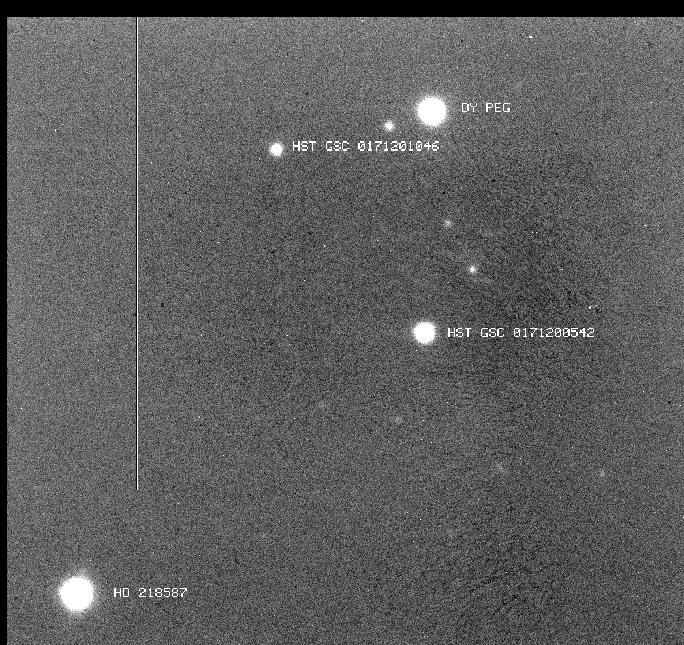 R band image of the DY Peg field.
R band image of the DY Peg field.
The frame coordinates of these four stars were found in each of the 92 frames. Using these coordinate lists, an aperature of 15 pixels, and an annulus from 18 to 23 pixels, qphot calculated the magnitudes of the four stars in each frame. The julian date of each observation was found by calculating the time between each observation and the first observation and then adding the Julian date of the first observation (found using the julday function in the IRAF astcalc package) to these times. The color of a star at a particular time was calculated by subtracting two subsequent V and R exposures. The magnitudes were left on the instrumental system.
HX Lac
Shown below is the trimmed 1.3' x 1.3' (230 x 230 pixels) field used for photometric analysis of HX Lac. The eclipsing binary as well as two stars used for comparison (labeled star 1 and star 2) are shown.
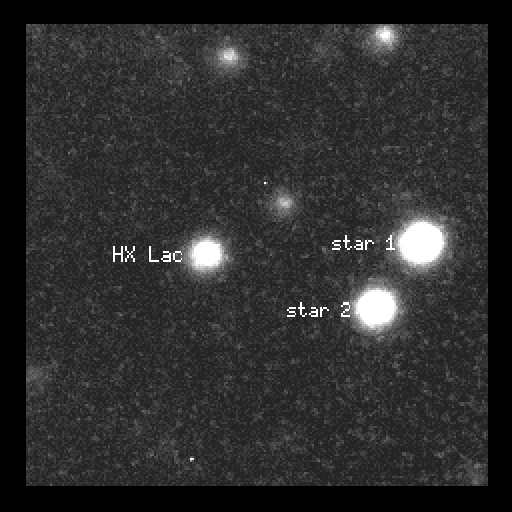 Trimmed image of the HX Lac
field.
Trimmed image of the HX Lac
field.
The IRAF package Daofind was used to get frame coordinates for these three stars in each of the fourty-four frames. These coordinate lists were then used with qphot, with an aperture of 15 and an annulus from 19 to 24, to determine the magnitudes of the three stars in each frame. The magnitudes were left on the instrumental system.
NGC 7789
Two runs through the mosaic data collection cycle produced 16 useful image frames and all the corresponding zeroes, darks, and flats. Of these 16, 8 were in R and 8 in V (two images per band from each quadrant of the four frame mosaic). The zero subtraction, dark correction, and flat-fielding was carried out as described earlier. For this cluster, the images were then combined into a mosaic. The first step in this process was to sum up the pair of images at each band-pass in each quadrant of the mosaic. Since the camera shifted slightly between each round of observations, each image within a given quadrant was off-center with respect to the other images from that quadrant. For every pair of images in each quadrant, one was shifted to the coordinate system of the other, and in all cases the x-y shift directions were chosen so that upon adding the pair together, the non-overlapping border would be only on the outside edge of the final mosaic. To make the final mosaic images were as smooth as possible, it was necessary at this point to add a small "bias level" to several of the quadrant images. This ensured that the mean dark sky counts in each quadrant were relatively close.
After shifting and summing each pair of R and V images in each quadrant, two separate mosaics were formed, one for each band. These mosaics were made by trimming off the central overlap regions from three of the four quadrants and then joining them together on a large, blank image. Special care was taken at this stage to make sure that the seams on the final mosaics (the lines between quadrants) were as unobtrusive as possible.
Now, with a completed mosaic image for each band, the IRAF geomap and geotran packages were used to align the two images together. Geomap and geotran used the coordinates for about 10 stars in both images to shift the axes of the R-band mosaic so that they matched those of the V band. Next, the daophot package was applied to create a list of the coordinates of every bright, well-resolved star in the crowded field (these coordinates were now identical in the R and V mosaics). This list was fed into qphot, which calculated the V and R magnitudes of each star. The magnitudes were left on the instrumental system.
M27
Ximtool was employed to make GIF files of the blue, green (or visual), and red filtered images of M27. For this analysis, the five minute exposures were used. The greyscale parameters z1 and z2 which yielded the best contrast were determined visually for each filter. For the blue filter image, these parameters were z1=230 and z2=595, for the green filter these were z1=516 and z2=881, and for the red z1=643 and z2=1008. Then the GIFs were loaded into Adobe Photoshop 5.5 where they were used to construct an RGB color-combined image.
Below are the blue, green, and red GIFs used to create the final color image.
Warner and Swasey Observatory / Case Western Reserve University / © 2001 / Last Updated Wednesday, December 5, 2001.
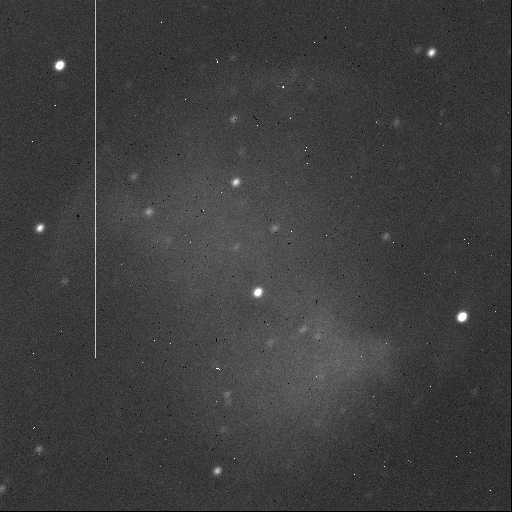 Blue (B) filter image of M27
Blue (B) filter image of M27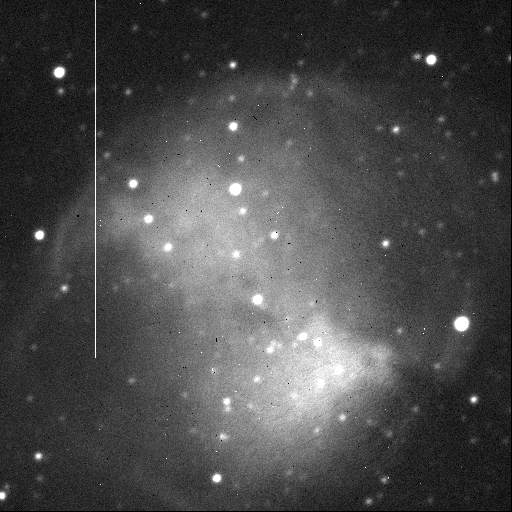 Green (V) filter image of
M27
Green (V) filter image of
M27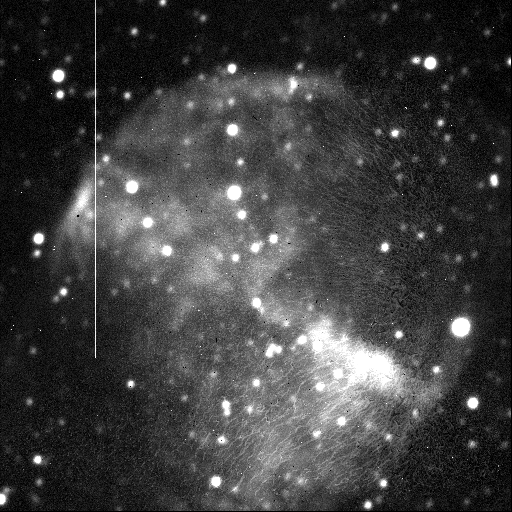 Red (R) filter image of M27
Red (R) filter image of M27